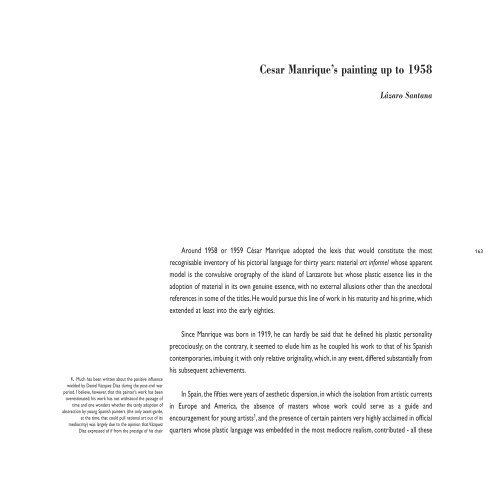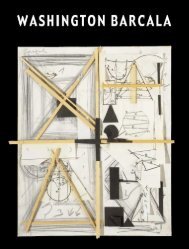VERSIÓN INGLESA ENGLISH VERSION - Fundación César Manrique
VERSIÓN INGLESA ENGLISH VERSION - Fundación César Manrique
VERSIÓN INGLESA ENGLISH VERSION - Fundación César Manrique
You also want an ePaper? Increase the reach of your titles
YUMPU automatically turns print PDFs into web optimized ePapers that Google loves.
1. Much has been written about the positive influence<br />
wielded by Daniel Vázquez Díaz during the post-civil war<br />
period. I believe, however, that this painter’s work has been<br />
overestimated; his work has not withstood the passage of<br />
time and one wonders whether the tardy adoption of<br />
abstraction by young Spanish painters (the only avant-garde,<br />
at the time, that could pull national art out of its<br />
mediocrity) was largely due to the opinion that Vázquez<br />
Díaz expressed of if from the prestige of his chair<br />
Cesar <strong>Manrique</strong>’s painting up to 1958<br />
Lázaro Santana<br />
Around 1958 or 1959 <strong>César</strong> <strong>Manrique</strong> adopted the lexis that would constitute the most<br />
recognisable inventory of his pictorial language for thirty years: material art informel whose apparent<br />
model is the convulsive orography of the island of Lanzarote but whose plastic essence lies in the<br />
adoption of material in its own genuine essence, with no external allusions other than the anecdotal<br />
references in some of the titles. He would pursue this line of work in his maturity and his prime, which<br />
extended at least into the early eighties.<br />
Since <strong>Manrique</strong> was born in 1919, he can hardly be said that he defined his plastic personality<br />
precociously; on the contrary, it seemed to elude him as he coupled his work to that of his Spanish<br />
contemporaries, imbuing it with only relative originality, which, in any event, differed substantially from<br />
his subsequent achievements.<br />
In Spain, the fifties were years of aesthetic dispersion, in which the isolation from artistic currents<br />
in Europe and America, the absence of masters whose work could serve as a guide and<br />
encouragement for young artists 1 , and the presence of certain painters very highly acclaimed in official<br />
quarters whose plastic language was embedded in the most mediocre realism, contributed - all these<br />
163
















![Becas y premios de la Fundación César Manrique [1997-2006]](https://img.yumpu.com/20766851/1/184x260/becas-y-premios-de-la-fundacion-cesar-manrique-1997-2006.jpg?quality=85)
